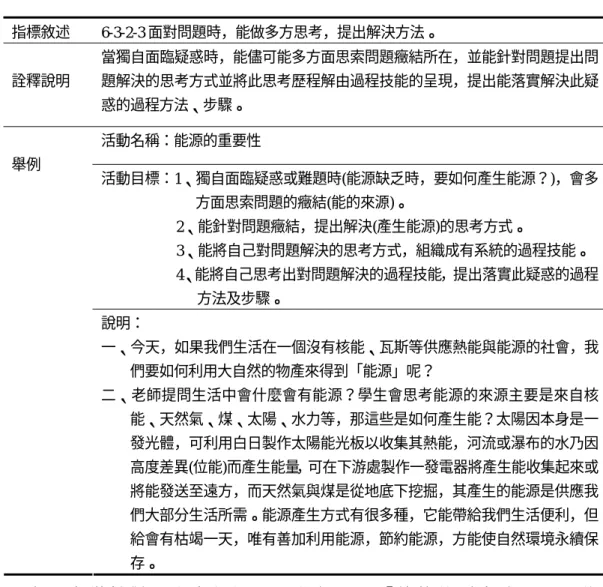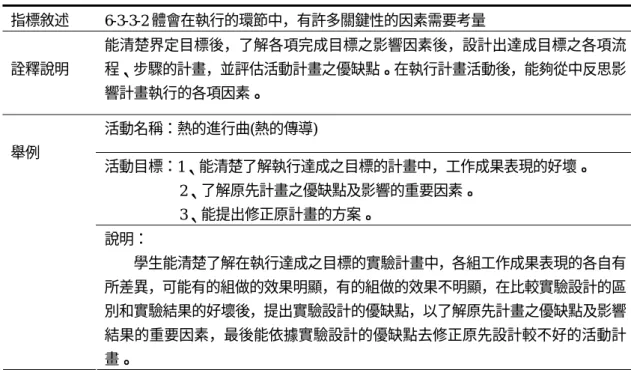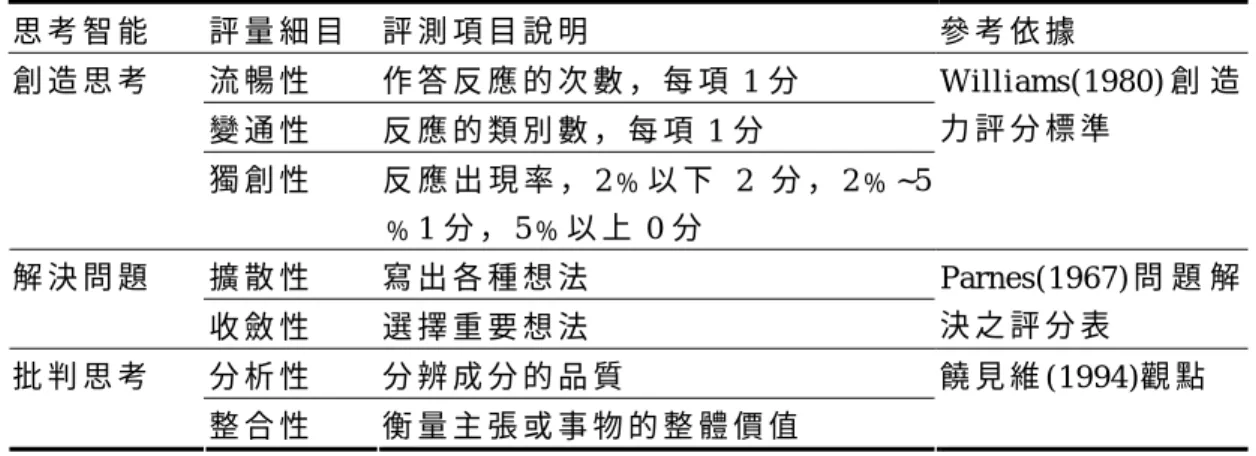An Exploratory Study of “ Heat Transfer”
Instructional Design and Performance
Assessment on Elementary School Student
Thinking Skills
Wen-Tung Hung*
Abstract
This study tried to develop “heat transfer” instructional design(abbrev. HTID)by revised creative problem solving model(abbrev. RCPS), the subject included 55 5th graders. The HTID includes three units, they are(1)heat conduction(2)heat convection(3)heat radiation. By contrastive analysis of RCPS instruction in an elementary classroom, the researcher found that the HTID can increase students’ creative thinking , critical thinking and problem-solving skills. Based on the findings of this study, the researcher proposed the HTID for nine-year-sequence curriculum in the domain of science and life technology and suggestions for future science education research.
Key words: Creative Thinking, Creative problem solving, Critical thinking, Heat transfer, Instructional design
.
自 智 力 中 加 以 區 分 出 來 。 Shymansky (1981)研 究 發 現 以 活 動 為 中 心 的 課 程 , 有 助 於 學 生 創 造 力 的 激 發 , 並 認 為 創 造 力 是 可 以 培 養 的 。 創 造 思 考 是 人 類 心 智 能 力 之 一 , 屬 於 高 層 次 認 知 歷 程 。 創 造 思 考 運 作 過 程 中 , 首 需 保 持 新 奇 、 求 變 、 冒 險 、 探 究 精 神 , 並 表 現 出 敏 覺 、 流 暢 、 變 通 、 獨 創 和 精 進 等 特 性 (張 玉 成 , 1993)。 創 造 力 在 不 同 的 知 識 領 域 中 , 會 發 展 出 不 同 領 域 的 創 造 力 , 而 科 學 創 造 力 即 是 在 既 有 的 科 學 知 識 基 礎 上 發 揮 出 來 。 換 言 之 , 由 於 每 個 人 之 科 學 知 識 之 涵 養 基 礎 不 同 , 再 加 上 個 人 之 思 考 特 性 之 不 同 , 而 在 科 學 創 造 力 層 次 上 就 有 個 別 差 異 性 (洪 文 東 , 1997)。 科 學 是 一 套 有 組 織 , 有 系 統 的 知 識 體 系 , 它 是 人 類 探 索 自 然 的 心 智 結 晶 , 也 是 人 類 文 明 進 展 的 智 慧 工 具 ; 而 在 科 學 發 展 的 進 程 中 , 科 學 創 造 力 更 佔 有 關 鍵 性 地 位 。 科 學 在 人 類 求 知 活 動 中 可 由 其 思 考 方 式 加 以 表 徵 , 尤 其 是 科 學 家 之 心 智 活 動 , 說 明 了 人 類 對 自 然 現 象 之 好 奇 心 與 求 知 慾 。 由 於 其 好 奇 心 、 信 念 、 及 價 值 觀 之 驅 使 , 促 使 他 們 能 夠 經 由 想 像 、 推 理 、 去 思 考 問 題 與 解 決 問 題 。 此 種 工 作 , 由 哲 學 與 認 知 心 理 學 觀 點 觀 之 , 即 是 一 種 創 造 性 活 動 , 因 為 他 們 已 在 心 靈 中 建 構 出 一 套 觀 念 去 合 理 的 解 釋 自 然 現 象 (Collette & Chiappetta,1994)。
Allen, R. R., & Rott Robert K. (1969). The nature of critical thinking. Report from the Concepts in Verbal Argument Project. Theoretical Paper No. 20. (ERIC
Document Reproduction Service No. ED036861).
Anderson, J. R.(1990). Cognitive psychology and it’s implication(3rd Ed. , N. Y.: W. H. Freeman and company)
Aylwin, S. (1985). Structure in thought and feeling. New York:Methuen.
Beyer, B. K.(1988). Developing a thinking skills program. Boston: Allyn& Bacon. Bereiter, C., & Scardamalia, M. (1985). Cognitive coping strategies and the problem of
‘inert knowledge’. In S. Chipman, J. Segal & R. Glaser (Eds.), Thinking and learning skills: Vol. 2. Research and open questions (pp. 65-80). Hillsdale, NJ: Erlbaum. Collette, A. T. & Chiappetta, E. C. (1994). Science Instruction in the middle and
science school (pp.27-47). Columbus, US: Merrill.
De Bono, E.(1992). Teach your child how to think. London: Viking. Devine, T. G.(1981). Teaching Study Skills. Boston: Allyn & Bacon. Dewey, J.(1933). How we think. Boston: D. C. Heath.
Ennis, R. H. (1987). A Taxonomy of Critical Thinking Dispositions and Abilities. In J. B. Baron & R. J. Sternberg (Eds.), Teaching Thinking Skills: Theory and Practice. New York; Freeman.
Gagne’, R. M., Briggo, L. J. & Wager, W. W.(1988). Principle of instructional design. New York: The Dryen Press Saunders College.
Guilford, J. P.(1967). The nature of human intelligence. New York: McGraw-Hill. Higgins, J. M.(1994).101 Creative problem solving techniques: The handbook of new
ideas for business. New Management Publishing Co, Inc.
Osborn, A. F.(1953). Applied imagination.(3rd Ed.)New York: Scribner’s. Parnes, S. J.(1967). Creative behavior guidebook. New York: Scribner’s. Marzano, Robert J. et al.(1988).Dimensions of thinking. Alexandria:ASCD. Mayer, R. E. (1992). Thinking, problem solving, cognition. New York: W. H. Freeman
and Company.
( ERIC_NO: EJ246279)
Torrance E. P.(1986). Teaching creative and gifted learners. In Handbook of Research on Teaching. 630-647. New York:Macmillan publishing company.
Treffinger D. J., & Isaksen S. G.(1992). Creative problem solving: An introduction. Center for Creative learning, Inc.
Wallas, G. (1926). Stage in the creative process. In A. Rothenberg and C. R. hansman (Eds.) The creativity question. Duke University Press,1976.
Wertheimer, M. (1945). Productive thinking. New York: Harper & Row.
Wheatley, G. H.(1991). Constructivist perspectives on science and mathematics learning. Science Education, 75(1), 9-21.
Yager, R. E.(1992). The STS approach parallels constructivist practices. Science Education International, 3(2), 18-20.


